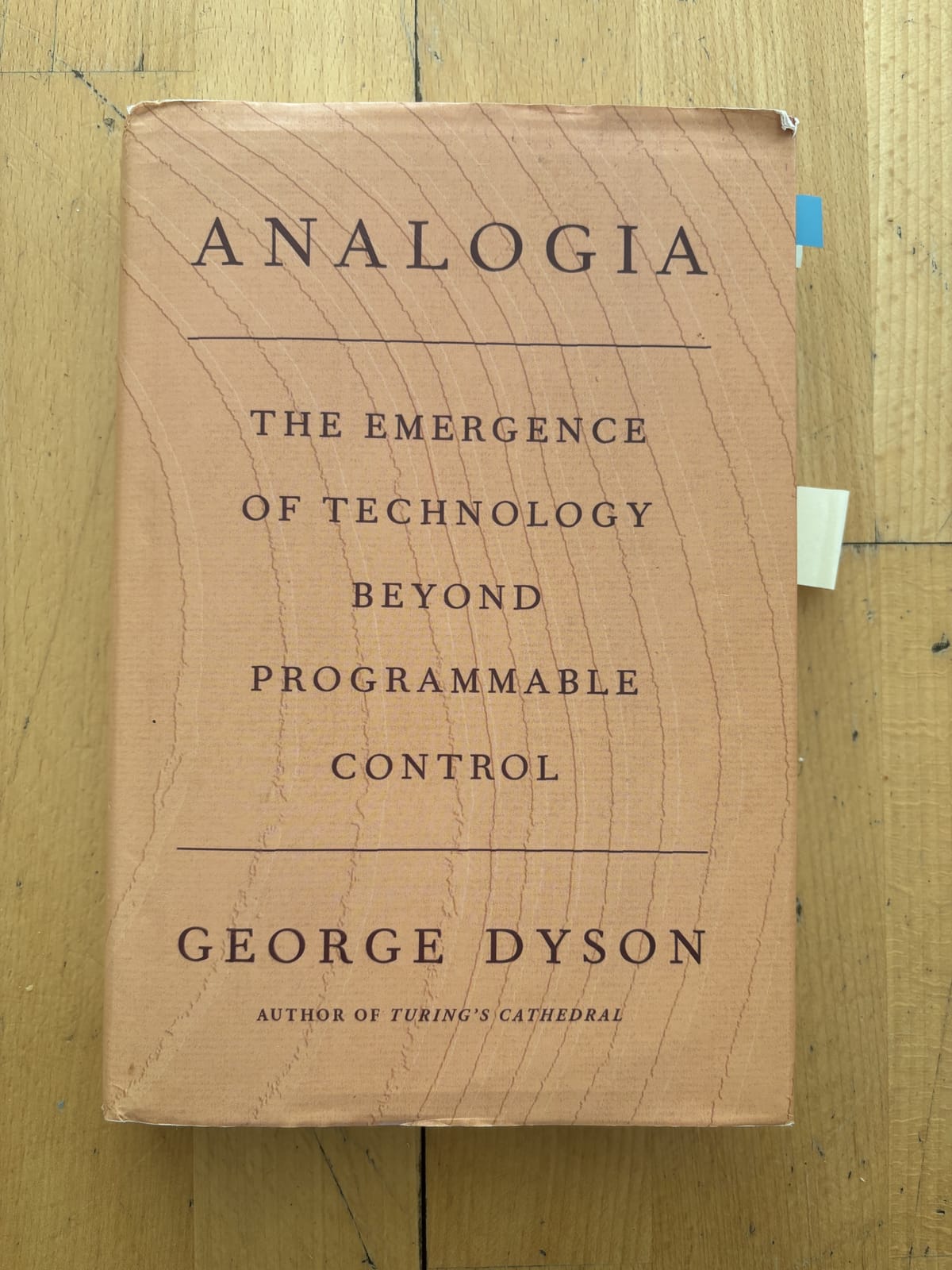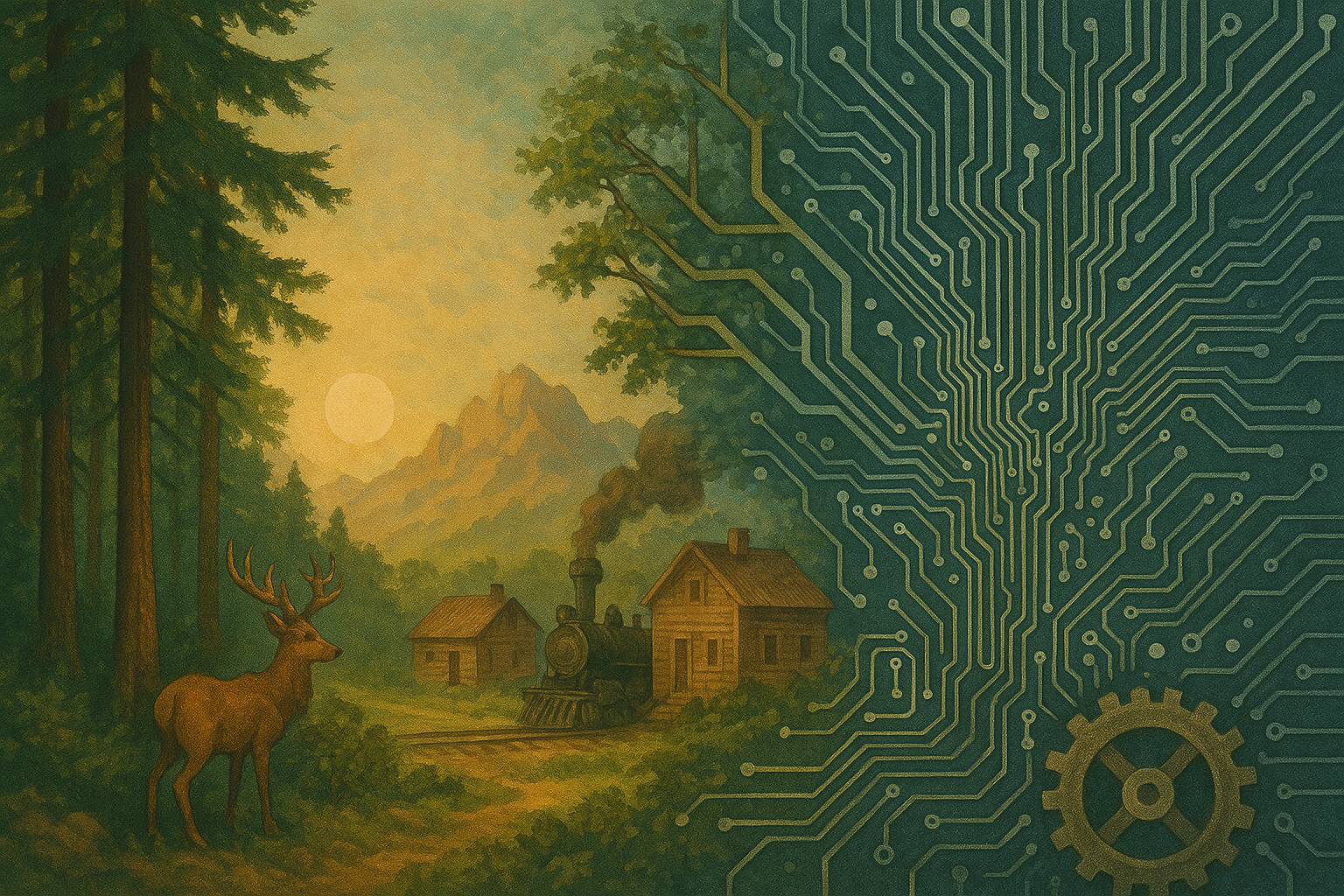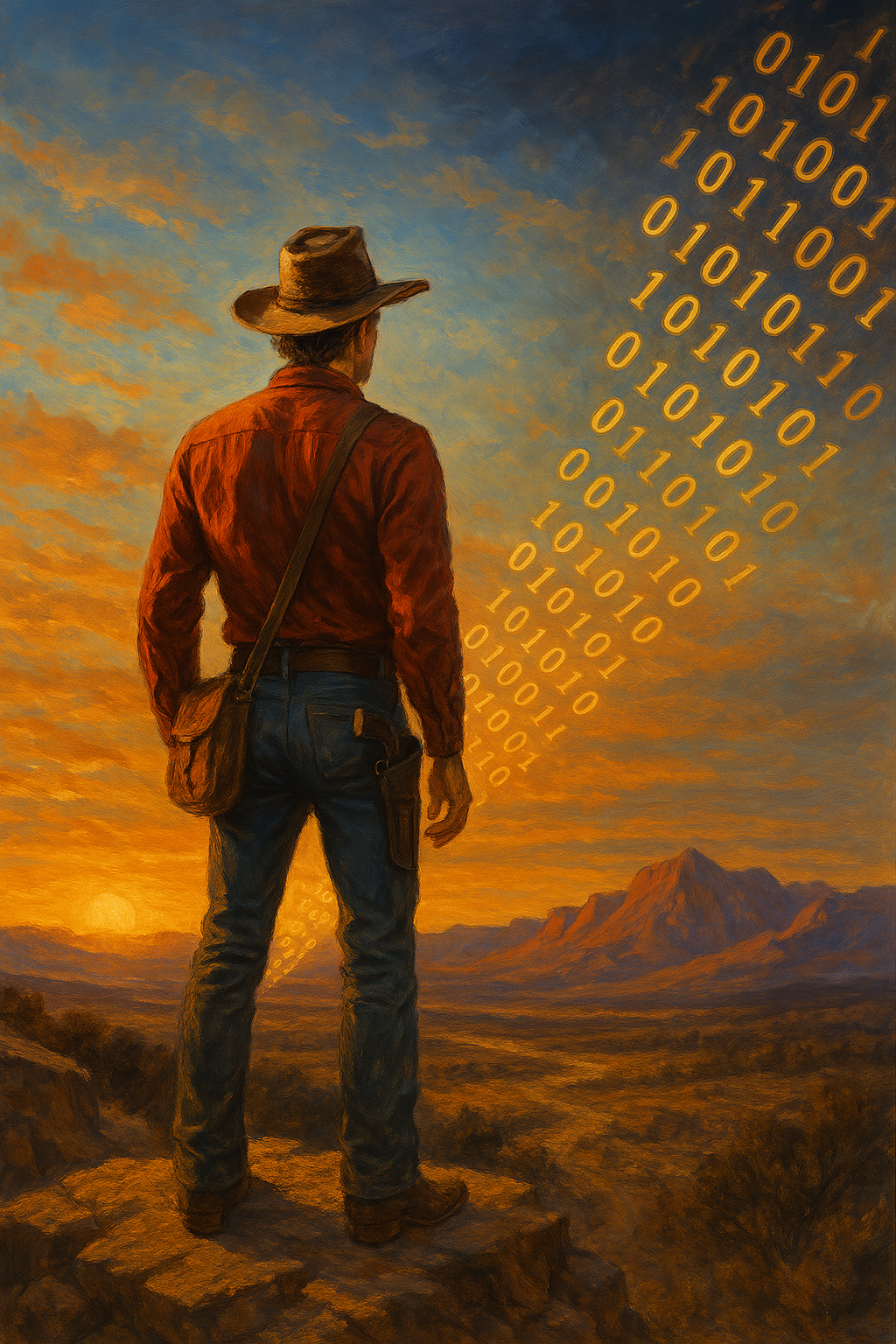Book review: Analogia by George Dyson

What if the future path of our relationship with computing technology could be best understood from the vantage point of a treehouse on the shore of a deeply cut fjord in British Columbia?
Year-rings are the life stories of trees reduced to digital form. Ocean waves scatter and superimpose regularly, just like the electromagnetism that facilitates all modern means of communication. The way a fir tree responds to storms instead accelerates a dwelling uncomfortably chaotically.

Analogia is a meditation on technological history, the settlement of the west, autobiography and a retelling of literary encounters with past visionaries that saw the lines blur between technology and the wild. Dyson feels deeply that we have landed in a “fourth epoch” in the “entangled destinies of nature, human beings and machines” in which “machines began taking the side of nature, and nature began taking the side of machines” (p. 7). The book draws you into the experiences of Dyson’s life, full of roaring tales from a life between trees and technology.
Dyson – whose first devotion in life is to revive and perfect the near-extinct sea-going baidarka kayak of the Northwestern coast – writes about humanity’s coexistence with computers with the width of his perspective. He removed himself from the action at a young age – while his family circles remained deeply involved in the scientific and business advances spurred by the 20th century’s computing acceleration. His heartfelt connection to the ecology of the American West informs a warmth and love for the exploratory human spirit – the expanses of our souls that push us to connect with nature and to invent the means to imitate it.
George Dyson’s childhood placed him among the inventors of the computer and the nuclear bomb – and his love for the American west, for kayaks and marine mammals lands him at age seventeen on a boat with a band, part of an experiment to test Killer Whales’ responses to Rock music in Blackfish Sound – 250 miles north of Vancouver. He liked it so much that he stayed on as a deckhand, built himself a treehouse across from Vancouver on Burrard Inlet and lived in it for three years.
This is the true mission of the book: to elucidate how we will relate to a world of ubiquitous, powerful, responsive and uncontrollable computing systems – based on the ideas and experiences of George Dyson himself, and the literary perspective of those (like Gottfried Wilhelm Leibniz, Samuel Butler and Leo Szilard – genius inventor of the nuclear chain reaction and author of arms control novella “Voice of the Dolphins) who have themselves foreseen that machines and nature will merge, by sharing evolutionary processes and by simply overpowering our own ability to act.
Writing in 2020, Dyson does not waste a single paragraph in the book on “deep-learning AI” that took off in the 2010s. Instead he gifts us glimpses into what it feels like to encounter “technology beyond programmable control” (the emergence of which in our time is the book’s subtitle and its main thesis) and links them to experiences of the wild’s vastness and its sometimes surprising uncontrollability.
He illustrates the arc of computing technology bending backwards towards its analog roots, where “complexity resides in architecture, not code” (p. 248) and aims to elucidate the consequences for us who interact with it: “In a digital computer, one thing happens at a time. In an analog computer, everything happens at once.” A brain encodes its information in its map of neural connections, not in “precise sequences of logical events” (p. 6).
In describing what it feels like to encounter – or rather to become a part of – such manifested information systems, he draws on vivid north-western encounters such as the “penetrating series of clicks” he felt as whales were scanning “the length of the kayak, the way we humans now scan our own offspring, in the womb, with ultrasound.” Killer whales communicate in the same medium in which they perceive the world – “If humans could communicate directly, brain to brain, using light, would we have developed languages based on a limited vocabulary of sounds (p. 133)?” A whole chapter is devoted to charting the role of North America’s “first large-scale, high-speed wireless data communications network” in the capture, exile and imprisonment of the continent's last free Apache group with its leader Geronimo.

As human beings our lives are intertwined with these information architectures, many of which we have created ourselves. These systems act on us and respond to us but their dynamics are outside of our individual control. And with that perspective comes Dyson’s incredibly astute observation, that the epoch of unprogrammable machines will engender for humankind a spiritual return to its pre-industrial era. When the direct experience of nature’s sublime and uncaring power populated a “spirit-laden landscape” – “surrounded by mind and intelligence everywhere we” looked (p. 8).
It is remarkable to juxtapose the achievements of computing science with the manifestations of the animus for exploration of the American continent. Gottfried Wilhelm Leibniz, the German librarian and mathematician, proposed to czar Peter the First of Russia an exploratory mission to the American northwest at the same time as he tried to interest him exporting his concept of a rational calculus (calculus rationator), a universal language related to Leibniz’ invention of a mechanical computer.
The westward journey for many of the physicists that left behind a war-torn, brutal, antisemitic and self-destroying Europe, did not end on the east coast. Many escaped victimhood and moved southwest to build the most terrifying weapon ever created and thereby win the war against the oppressors of their home continent. They sacrificed their consciences to defend their freedom. Computing power was a key enabler of the bomb, because for the first time fast calculations made it possible to simulate and inspect the explosions they wanted to cause.
George Dyson, his physicist father and his mother – a mathematical logician – bounced regularly between Princeton’s Institute of Advanced Studies and the west coast. He was five when his father Freeman was invited to design a nuclear explosion powered-spaceships called “Project Orion” on the Pacific shore of San Diego under the motto of “Saturn by 70” (p. 122). Freeman’s lesson as one of the bomb’s creators was to build more nukes but use them to propel freedom and exploration (p. 120):
“1. There are more things in heaven and earth than are dreamed of in our present-day science. And we shall only find out what they are if we go out and look for them.
2. It is in the long run essential to the growth of any new high civilization that small groups of men can escape from their governments and go and live as they please in the wilderness. Such isolation is no longer possible on this planet.
3. We have for the first time found a way to use the huge stockpiles of our bombs to better purpose than for murdering people.”
The quest for individual freedom, the joy of exploration and a deep seated – if unconventional – moral compass still characterise those journeying westward to unleash the exponentially accelerating power of computing.
Back in Princeton, ten year old George’s playground was a barn with analog electronics from John von Neumann’s “Electronic Computer Project”. But the wild beckoned him strongly, too, and via Colorado and San Diego he ultimately found himself in Blackfish Sound near Vancouver.
The strangest, most personal and central chapter of the book – “Tree House” – is devoted to an economic and anthropological history of British Columbia, a detailed account of where and how Dyson happened upon the shore that nourished the Douglas fir that he would call home, an account of the dangers of floating logs and the opposing interests of beachcombers and logging companies to salvage them. He describes the capture of the 30 ft red cedar log he split and made his house from and lauds the advantages of its wood:
“Humans and cedar flourished together on the Northwest Coast. Infants born in cedar longhouses to clans identified by carved cedars house posts were swaddled in cedar-fiber diapers, nourished by food stored in cedar boxes and served dishes the size of wheelbarrows, while growing up to wear woven cedar cloaks under woven cedar hats. After death, their remains were wrapped in cedar bark matting, packed into cedar boxes, and paddled, in cedar canoes, to burial islands where they were hoisted back into the trees, using cedar bark ropes (p. 160).”
The story of the settlement of Dyson’s corner of the Indian Arm fjord north of Vancouver involves a village of the Tsleil-Waututh people which is now the location of a park for weekend trippers, a crafty Irishman called John Hall who secured the title on the area with threats against these villagers and murdered his native American mother-in-law in 1882. His lawyer William Norman Bole lost the case, but managed to buy the land from Hall before he was sent off to a hard labour camp. Bole turned the area into a vacation destination. Human rules, meaning and unbendable norms shape the evolution of the land and the lives of the people on it. When Dyson showed up in 1972 he cared about this information architecture only as much as he wanted to fall through its cracks: “Who had jurisdiction over a structure in a tree? (p. 161)”

Rules, norms, customs and ideas acquired the “power of self-replication” through the human brain as their host and mutation agent, thereby entangling the very substrate of their evolution into ever stronger individual submission through states and property codes. Numbers acquired this power only through computing, where they represent both instructions and the data on which they are carried out. When “the distinction broke” “between numbers that mean things and numbers that do things, all hell broke loose, starting with the hydrogen bomb, as a result” (p. 226). “A model of the social graph becomes the social graph.” “A search … engine will control meaning, in the same way as a the traffic map controls the flow of traffic, even though no one is in control (pp. 250).”
These types of unstoppable dynamics, intermingled with and mediated by human actions, on a trajectory set solely by the evolution of computing power, most clearly paint how we will individually experience : “the rise of analog systems over which the dominion of digital programming comes to an end (p.252).”


